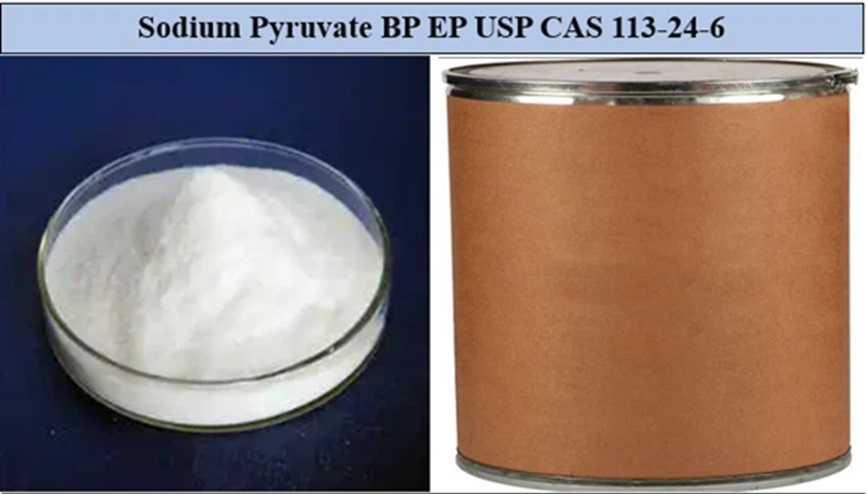We unleash your business potential by maximize the business innovation.
Send EmailSodium Pyruvate, Natrium Pyruvat, Sodium Oxopropanoate, Sodium Ketopropionate, 113-24-6
Sodium pyruvate (CAS No. 113-24-6) is the sodium salt of pyruvic acid, widely used in biological research, cell culture, and biochemical applications.
Chemical Identity
-
IUPAC Name: Sodium 2-oxopropanoate
-
Molecular Formula: C₃H₃NaO₃
-
Molecular Weight: 110.04 g/mol
-
Appearance: White to slightly yellow crystalline powder
-
Melting Point: >300 °C
-
Solubility: Highly soluble in water; very slightly soluble in ethanol
-
pH (1% solution): ~7.0
-
Storage: 2–8 °C, dry and sealed conditions
Applications
-
Cell Culture: Supplemented in media as an energy source; supports ATP production
-
Antioxidant Role: Scavenges reactive oxygen species (ROS), protecting cells from oxidative stress
-
Metabolic Research: Intermediate in glycolysis, TCA cycle, and amino acid metabolism
-
Microbial Growth: Used as a carbon source in bacterial and yeast cultures
-
Pharmaceuticals: Investigated for neuroprotective and metabolic support roles
Safety & Handling
-
Hazard Statements:
-
H317: May cause allergic skin reaction
-
H319: Causes serious eye irritation
-
-
Precautions: Use gloves and eye protection; avoid inhalation of dust
-
WGK (Germany): 1 (low hazard to water)
Sodium Pyruvate
Other Names: Sodium 2-oxopropanoate, Pyruvic acid sodium salt Chemical Formula: C₃H₃NaO₃ Molecular Weight: 110.04 g/mol Appearance: White to slightly yellow crystalline powder Solubility: Freely soluble in water; very slightly soluble in alcohol pH (1% aqueous): ~7.0 Storage: Store tightly sealed at 2–8 °C in a dry environment
Production Method
Sodium pyruvate is industrially synthesized by neutralizing pyruvic acid with sodium hydroxide:
CH3COCOOH+NaOH→CH3COCOONa+H2OCH_3COCOOH + NaOH \rightarrow CH_3COCOONa + H_2O
This process can involve intermediate steps starting from tartaric acid or via decarboxylation of oxaloacetate, followed by purification and crystallization. Final drying is typically done under vacuum.
Applications
-
Cell Culture: Acts as a metabolic energy source and supports cell viability
-
Antioxidant Action: Scavenges reactive oxygen species (e.g. H₂O₂), protecting cells from oxidative damage
-
Pharmaceutical Research: Explored for neuroprotective properties, especially in ischemia or hypoxia models
-
Biotech and Microbiology: Serves as a carbon source for microbial and yeast cultures
-
Cosmetics: Used in formulations for anti-aging and skin-brightening effects
-
Food Applications: Naturally found in fermented products; contributes to flavor
Reactions and Biochemical Roles
-
Converts to lactic acid under anaerobic conditions
-
Participates in transamination reactions forming alanine
-
Enters the TCA cycle via acetyl-CoA after oxidative decarboxylation
-
May transform back into pyruvic acid in acidic conditions
Possible Substitutes
Depending on the intended use:
-
Lactic Acid – for acidification or energy roles in biological contexts
-
Acetic Acid – simpler carbon donor but lacks antioxidant function
-
D-Glucose – primary energy source in media, but doesn’t buffer oxidative stress
-
Glutamine or Alanine – alternative metabolic energy/amino acid sources
-
Calcium Pyruvate – sometimes used in food and supplement applications
Sodium Pyruvate (CAS No. 113-24-6) that you can include in your product listing or documentation:
-
Pyruvic acid sodium salt
-
Sodium 2-oxopropanoate
-
2-Oxopropanoic acid sodium salt
-
α-Ketopropionic acid sodium salt
-
Propanoic acid, 2-oxo-, sodium salt
-
Natriumpyruvat (German)
-
Natrium-2-oxopropanoat
-
Sodium α-ketopropionate
-
Sodium pyruvate-1-13C / -2-13C / -13C₃ (isotopically labeled forms)
